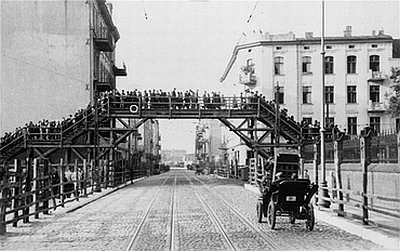Zgierska Street - Masarska Street (no longer in existence) - Podrzeczna Street (Hohensteinerstrasse - Storchengasse - Am-Bach)
From the start, Zgierska and Limanowskiego streets were excluded from the ghetto. These were important arteries, which belonged to the Aryan side of Litzmannstadt. A tram ran along the route; cars and bicycles passed. The ghetto, cut up by these streets, was subsequently divided into three parts. At first, special gates were opened at certain hours, so that the inhabitants could move from one part to another. There were three such gates: two on Zgierska Street (at Drewnowska Street near Stary Rynek, and at Dolna-Lotnicza Street), and a third one at Limanowskiego Street, between Rybna and Ciesielska streets. To ease the situation, in the summer of 1940 three wooden footbridges were erected, allowing the people in the ghetto to move from one section to another at any time.
 One of the bridges was located over Zgierska Street at Lutomierska Street, next to the St. Mary's Assumption's Church; a second one was located further south on Zgierska, at Podrzeczna Street; and a third crossed over Limanowskiego Street at Masarska Street (where today Zachodnia Street runs).
One of the bridges was located over Zgierska Street at Lutomierska Street, next to the St. Mary's Assumption's Church; a second one was located further south on Zgierska, at Podrzeczna Street; and a third crossed over Limanowskiego Street at Masarska Street (where today Zachodnia Street runs).
Zgierska and Limanowskiego streets were fragments of a different world, to which the people from the confined district had no access. Climbing the bridge was an occasion to glance at the world outside of the ghetto. It was also a place where numerous suicides were committed. The bridges of the Lodz ghetto, most particularly the one by the church, can be seen in many historical photographs, drawings and paintings. It is one of the most recognizable pictures of those tragic events. It became a symbol of the Lodz ghetto.
Passing through that bridge was a significant effort, a physical one for some, a mental one for others. The steep stairs posed a great difficulty to the elderly, ill and weakened people, especially in the winter. When standing on the bridge and looking to the south, one had a perspective of part of Zgierska, Nowomiejska and Piotrkowska streets, which cut through the city with a straight line. In that perspective some tried to find the elements of city life, like traces of life in outer space; others would nostalgically recall their past normal lives in the far downtown skyline, a normalcy which was often grey, empty, dull, in which they had hardly ever lived happily, unaware of how many different natures happiness can have... Then one would go down and to the right one had the church of the Holiest Virgin Mary, whom the Germans had resettled like an ordinary Jewish woman from Wschodnia Street.
Arnold Mostowicz, The Yellow Star and the Red Cross, p. 24.
A disastrous incident occurred today. On Limanowskiego Street, the road excluded from the ghetto, a ten-year-old boy threw a stone for fun through the wires to the other side of the street, but hit a passing tram and broke one of its windows. The Jews were instantly forbidden to walk the wire fenced streets, the boy was taken by the Jewish police for the time being, and Rumkowski was dashing around like crazy. Let's hope nothing bad results from it.
Dawid Sierakowiak, Diary, June 1, 1941, p. 26.
Sometimes I would take Rysia for a walk to Zgierska Street, along the barbed wire fence and through the bridge, which linked two parts of the ghetto together. When we were standing on the bridge I would tell Rysia about .Flac Wolnosci, located at the end of Zgierska Street, and about the monument of the Polish hero, which the Germans had blown up. And there, I continued, just three houses away, there stood my parents' house, where I had been so happy.
One day, when we were standing on the bridge, Rysia asked if the Jews had looked different before the war, and if they had ever resembled people of non-Judaic faith.
She became nervous when I did not understand what she meant, and she demanded that I describe what the Poles and Germans exactly look like. When she heard that actually there was no difference between Gentiles and Jews, she pondered for a while and eventually asked: "So why do they isolate themselves from us?"
I couldn't answer her, for I had been incessantly asking myself an identical question.
Sara Zyskind, The Stolen Years, p. 144.
As a result of abundant snowfall, the traffic was disrupted in the ghetto and outside of it. The ghetto bridges in particular were so crowded because of the hindered passing that only one person at a time could be let through, and thus many workers and officials came to work one hour late.
The trams had to be stopped because of snowdrifts; for the first time the Germans and the Poles had to go on foot along Zgierska and Limanowskiego streets. An unusual view could be observed: the Aryans walked the road, and the Jews the pavements.
The Chronicle of the Lodz Ghetto, December 3, 1942, Vol. 2, p. 417.

 Home
Home
